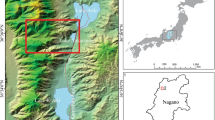Abstract
A considerable thickness of anhydrite has been removed by solution from Magnesian Limestone of County Durham in North-east England. To the west the extent of the anhydrite was formerly limited by the front of the well known Permian reef complex. The anhydrite beds thickened to the east and have been proved in borings a few miles offshore.
Solution of the anhydrite has been ascribed to circulating groundwaters. The general circulation, and hence solution of anhydrite, would have been limited to the east by the fresh to saltwater interface approximately coincident with the present coastline.
By using the methods available for predicting ground strains and subsidence associated with the underground mining of coal seams, it is possible to predict:
-
(a)
the direction and position of maximum surface strain in the limestones above the anhydrite
-
(b)
the localiation of brecciation in the associated limestones as the anhydrite was removed.
The resultant changes in the mass properties of the formerly well-bedded limestones are described and discussed.
Résumé
Une puissance considérable d'anhydrite a été enlevée par dissolution du calcaire magnésien de County Durham, au nord-est de l'Angleterre. Autrefois l'extension de l'anhydrite vers l'ouest était limitée par le front d'un récif permien bien connu. Les bancs d'anhydrite s'épaississaient vers l'est; leur présence a été prouvée par des forages à une distance de quelques miles en mer. La dissolution de l'anhydrite a été attribuée à l'eau souterraine. La circulation en général, et donc la dissolution de l'anhydrite, aurait été limitée vers l'est par une zone d'interface entre l'eau douce et l'eau salée. Cette zone coïncide approximativement avec la côte actuelle.
En utilisant des méthodes existantes pour l'étude des déformations souterraines et la subsidence liée à l'exploitation des couches de charbon, il est possible de prédire:
-
(a)
la direction et la position de la déformation maximale en surface dans les calcaires au-dessus de l'anhydrite
-
(b)
la localisation de la bréchification dans les calcaires associés quand l'anhydrite est dissoute.
On décrit et on discute des propriétés de massifs en résultant. Les changements qui en résultent dans les propriétés des masses calcaires initialement bien litées sont décrits et discutés.
Similar content being viewed by others
References
ANON. (1978): Sunderland Sheet 21, 1:50 000 Series, Solid and Drift Edition. Geological Survey of Great Britain (England and Wales). Institute of Geological Sciences.
DEARMAN, W. R. and COFFEY, J. R. (1981): And engineering zoning map of the Permian limestones of N.E. England. Q. Jl Engng. Geol., 14, 41–57.
HICKLING, G. and HOLMES, A. (1931): The brecciation of the Permian rocks, in: Contributions to the Geology of Northumberland and Durham. Proc. Geol. Assoc., 42, 217–296.
HICKLING, G. and ROBERTSON, T. (1949): Geology, in: Scientific Survey of North-Eastern England, British Association Local Executive Committee, Newcastle upon Tyne. 10–30.
LEBOUR, G. A. (1884): On the Breccia-Gashes of the Durham coast and some recent earthshakes at Sunderland. Trans N. England Inst. Min. Mech. Engrs., 33, 165–177.
LEBOUR, G. A. (1889): Outlines of the Geology of Northumberland and Durham. 2nd Ed. Newcastle upon Tyne, Lambert & Co., 219 pp.
McGRAW, D. (1975): Permian of the offshore and coastal region of Durham and S.E. Northumberland. Jl Geol. Soc. Lond., 131, 397–414.
NATIONAL COAL BOARD (1975): Subsidence Engineers' Handbook, National Coal Board, Mining Department. 111 pp.
ROCKAWAY, J. D. and LUTZEN, E. (1970): Engineering Geology of the Creve Coeur Quadrangle, St. Louis County, Missouri. Engineering Geology Series No. 2. Missouri Geological Survey and Water Resources.
SMITH, D. B. (1971): The stratigraphy of the Upper Magnesian Limestone in Durham: a revision based on the Institute's Seaham Borehole. Report No. 71/3, Inst. Geol. Sci., 12 pp.
TRECHMAN, C. T. (1913): On a mass of anhydrite in the Magnesian Limestone at Hartlepool and on the Permian of South-Eastern Durham. Jl Geol. Soc. 69, 184–218.
VARNES, D. J. (1974): The logic of geological maps with reference to their interpretation and use for engineering purposes. U.S. Geol. Surv. Prof. Paper 873, 48 pp.
WOOLACOTT, D. (1919): The Magnesian Limestone of Durham. Geol. Mag., 6, 452–465 and 485–498.
Author information
Authors and Affiliations
Rights and permissions
About this article
Cite this article
Dearman, W.R., Coffey, J.R. Effects of evaporite removal on the mass properties of limestone. Bulletin of the International Association of Engineering Geology 24, 91–96 (1981). https://doi.org/10.1007/BF02595259
Published:
Issue Date:
DOI: https://doi.org/10.1007/BF02595259




